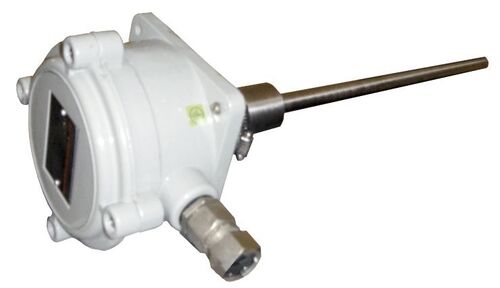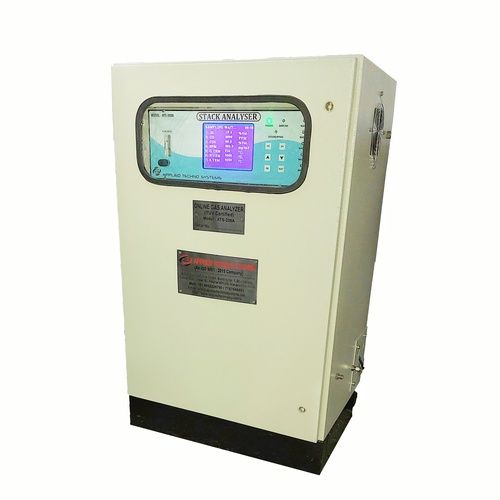- Dew Point Meters
- Gas Analysers
- Portable Gas Detector
- Moisture And Dew Point Analyzer
- Dust/Opacity Monitor
- Gas Monitoring Systems
- Gas Leak Detectors
- Gas Transmitters
- VOC Leak Detector
- Air Quality Monitoring System
- Online Continuous Emission Monitoring System-OCEMS
- Dew Point Monitors
- Gas Detector
- Opacity Monitor
- Portable Flue Gas Analyzer
- Online SOX & NOX Gas Analyzer
- Methane Gas Leak Detector
- Hydrogen Purity Analyzer
- Gas Purity Analyzer
- Effluent Monitoring Systems
- Producer Gas Analyzer
- Gas Detector Calibration Service
- Portable Gas Monitors
- Gas Sensor Transmitter
Environmental Emissions Monitoring Systems
Price 1050000 INR/ Unit
Environmental Emissions Monitoring Systems Specification
- Mounting Type
- Wall / Rack Mounted
- Test Range
- 0.1 ~ 1000 ppm
- Frequency
- 50 Hz
- Operating Voltage
- 220 V AC
- Gas Pressure
- 0.1~0.6 MPa
- Temperature
- -10C ~ 50C
- Display Type
- Graphics Display
- Color
- Grey
- Interface Type
- RS232 / USB / Ethernet
- Resolution
- 0.1 ppm
- Port Size
- 1/4 inch
- Product Type
- Monitor
- Power Supply
- 220 V AC, 50 Hz
- Automation Grade
- Automatic
- Features
- Continuous Monitoring, Real-Time Data, Multi-parameter Detection
- Response Time
- 10 seconds
- Max Height
- 400 mm
- Equipment Type
- Environmental Emissions Monitoring Systems
- Application
- Industrial Emissions Testing, Air Quality Monitoring
- Measuring Range
- 0.1 ~ 1000 ppm
- Specimen Size
- Standard
- Number of Specimens
- 1-3 Channels
- Humidity
- 5% ~ 95% RH (Non-condensing)
- Usage
- Industrial
- Capacity
- Up to 3 probe connections
- Machine Weight
- 90 kg
- Test Speed
- 5-50 mm/min
- Test Width
- 150 mm
- Test Stroke
- 300 mm
- Control Mode
- Automatic
Environmental Emissions Monitoring Systems Trade Information
- Minimum Order Quantity
- 1 Unit
- Payment Terms
- Cash Advance (CA), Cash in Advance (CID), Cheque
- Packaging Details
- As Per Customer Requirement
- Main Export Market(s)
- Asia, Australia, Central America, North America, South America, Eastern Europe, Western Europe, Middle East, Africa
- Main Domestic Market
- All India, South India, Central India, West India, North India, East India, Gujarat, Karnataka, Kerala, Lakshadweep, Mizoram, Meghalaya, Manipur, Andhra Pradesh, Bihar, Chandigarh, Daman and Diu, Goa, Jharkhand, Odisha, Punjab, Assam, Delhi, Dadra and Nagar Haveli, Andaman and Nicobar Islands, Arunachal Pradesh, Chhattisgarh, Haryana, Himachal Pradesh, Jammu and Kashmir, Madhya Pradesh, Maharashtra, Nagaland, Rajasthan, Sikkim, Tamil Nadu, Telangana, Tripura, Pondicherry, Uttar Pradesh, Uttarakhand, West Bengal
- Certifications
- An ISO 9001:2015 Company
About Environmental Emissions Monitoring Systems
Environmental Emissions Monitoring Systems (CEMS) are technologies and tools used to measure, analyze, and track pollutants released into the air, water, or soil by industrial processes, transportation, and other sources. These systems are essential for ensuring compliance with environmental regulations, assessing the impact of emissions on air quality, and enabling industries to monitor their environmental footprint.
- Continuous Emission Monitoring: EEMS often include Continuous Emissions Monitoring Systems (CEMS) that provide real-time data on pollutants such as carbon dioxide (CO), nitrogen oxides (NO), sulfur dioxide (SO), particulate matter (PM), and volatile organic compounds (VOCs) emitted from sources like smokestacks, industrial plants, and power stations.
- Data Collection and Reporting: These systems are designed to collect data continuously or at frequent intervals, which is then analyzed and reported. This data helps regulators ensure that industries comply with emission limits and environmental standards.
- Real-Time Monitoring: Many EEMS provide real-time feedback, alerting operators or environmental authorities when emissions exceed permitted levels. This helps mitigate environmental damage by enabling timely corrective actions.
- Data Logging and Storage: EEMS typically store data for long periods, allowing for historical analysis, trend monitoring, and regulatory reporting. This is particularly important for compliance with laws that require records to be kept for a specific duration.
- Integration with Regulatory Standards: EEMS are designed to measure pollutants according to established standards, such as those set by the Environmental Protection Agency (EPA) in the U.S., the European Union Emission Standards, or other local environmental authorities


Price:
- 50
- 100
- 200
- 250
- 500
- 1000+
More Products in Online Continuous Emission Monitoring System-OCEMS Category
insitu zirconia based oxygen analyzer
Price 175000 INR / Piece
Minimum Order Quantity : 1 Piece
Power Supply : Electric
Accuracy : +2 %
Features : Good Quality
Temperature : 15 Celsius (oC)
Industrial Stack Monitoring System
Price 62500 INR / Set
Minimum Order Quantity : 1 Set
Power Supply : Electric
Accuracy : +2 %
Features : High Quality
Temperature : 15 Celsius (oC)
Continuous Emissions Monitoring Systems (SPM)
Price 120000 INR / Number
Minimum Order Quantity : 1 Number
Power Supply : Electric
Accuracy : +2 %
Features : High Quality
Temperature : 5 to 55 Celsius (oC)
Online Continuous Stack Emission
Price 1000000 INR / Number
Minimum Order Quantity : 1 Number
Power Supply : Electric
Accuracy : +2 %
Features : High Quality

 Send Inquiry
Send Inquiry





 English
English Spanish
Spanish French
French German
German Italian
Italian Chinese (Simplified)
Chinese (Simplified) Japanese
Japanese Korean
Korean Arabic
Arabic Portuguese
Portuguese